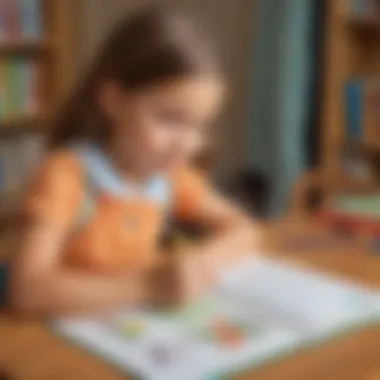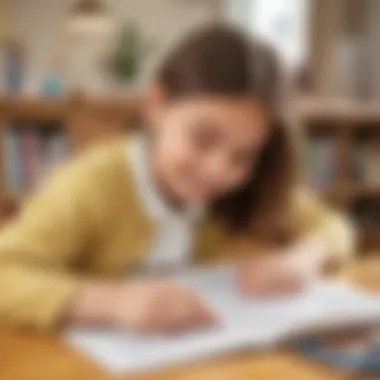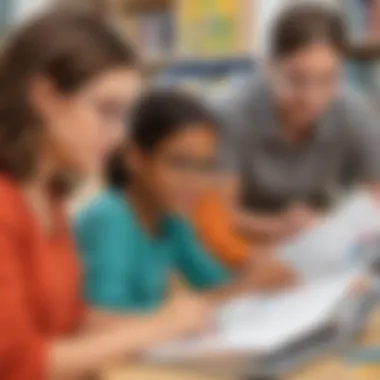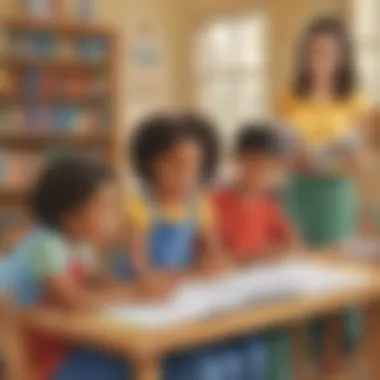Innovative Literacy Worksheets for Young Learners


Intro
In today’s fast-paced world, nurturing literacy skills in young children has become more important than ever. From the moment they set foot in preschool to their early tweens, kids embark on a journey of discovering words, stories, and self-expression. Innovative literacy worksheets can serve as crucial anchors in this adventure, guiding children not just to read and write but to engage with language in a way that ignites their imaginations.
Worksheets today are not just black-and-white papers filled with dull tasks. Instead, they are vibrant and interactive tools that can grab a child's attention and keep them engaged. By aligning these worksheets with academic standards, educators and parents can ensure that kids are not only having fun but are also on the right track educationally. The charm of literacy worksheets lies in their versatility; they can be adapted to various subjects and learning styles, providing ample opportunities for kids to thrive.
This article aims to provide a thorough exploration of the role of innovative literacy worksheets in enhancing learning. We’ll examine various types of worksheets available for children aged three to twelve, the significance of aligning them with curricula, and the many strategies educators and parents can employ to maximize their effectiveness. Together, we will delve into how these worksheets can foster critical thinking, creativity, and, most importantly, a genuine love for learning in young minds.
Now, let's kick things off by exploring the world of interactive learning games that can complement these literacy worksheets.
Understanding Literacy Worksheets
Literacy worksheets are vital tools in shaping children's reading and writing abilities. As educators, parents, and caregivers navigate the complex terrain of literacy development, understanding how these worksheets function can illuminate their significance in everyday learning. Worksheets bridge gaps between theoretical knowledge and practical application. They offer structured activities that not only reinforce skills but also introduce new concepts in an engaging way. These worksheets are designed to cater to various learning styles, ensuring inclusivity in literacy education. Given that many children encounter difficulties in grasping complex language concepts, worksheets serve as a personalized aid in their learning journey.
Definition and Purpose
In the simplest terms, literacy worksheets are carefully crafted educational tools that focus on enhancing reading, writing, and comprehension skills. Their primary purpose lies in providing organized tasks that hone specific literacy skills. For instance, a phonics worksheet might include exercises that ask students to identify sounds, while a comprehension worksheet could present stories followed by questions that encourage critical thinking.
Worksheets also serve as a platform for self-assessment, allowing children to track their progress. As they work through the tasks, students can observe their growth and areas needing improvement. Furthermore, they promote independent learning, giving children the chance to explore literacy concepts at their own pace. This independence is crucial, as it builds confidence and fosters a love for reading and writing.
The Role of Worksheets in Literacy Development
Worksheets play a pivotal role in literacy development by offering a structured approach to learning. When children engage with these worksheets, they learn to decode text, understand context, and express ideas clearly. Here are some of the key roles worksheets fulfill:
- Skill Reinforcement: Worksheets provide repetitive practice, which is essential in reinforcing foundational skills such as phonics and vocabulary.
- Variety of Activities: From matching exercises to fill-in-the-blank tasks, worksheets come in many formats, keeping learning fresh and stimulating.
- Feedback Loop: Immediate answers on worksheets give children instant feedback. This helps them adjust their understanding and fosters a sense of achievement when they get things right.
- Focus on Individual Needs: Educators can tailor worksheets to accommodate different learning levels, ensuring that all children can benefit from them.
Overall, literacy worksheets are not just simple paper exercises; they are comprehensive tools that nurture young learners. Through thoughtful design and implementation, these worksheets enhance the literacy landscape, making learning both effective and enjoyable.
Types of Literacy Worksheets
In the dynamic realm of literacy education, worksheets serve as vital tools that cater specifically to the nuanced needs of young learners. Each type of worksheet brings distinct advantages to the table, promoting not just rote learning but also a deeper understanding of language fundamentals. The incorporation of various worksheet types enables educators to cultivate a well-rounded literacy experience, enhancing critical thinking, engagement, and retention among children. Exploring the specific elements of each kind unveils their unique benefits and considerations as essential resources in the developmental journey of young minds.
Phonics Worksheets
Phonics worksheets are designed to strengthen a child’s ability to connect sounds with letters or groups of letters. These worksheets not only facilitate the understanding of phonetic principles but also create paths to decoding skills. Many educators have found that incorporating phonics worksheets into early literacy programs can significantly improve reading accuracy and fluency.
Common activities in phonics worksheets include:
- Sound recognition exercises: Helping children identify and produce sounds associated with letters.
- Matching games: Associating pictures with words that start with the same sound.
- Phoneme blending tasks: Where kids combine individual sounds to form words.
Engaging with these kinds of exercises lays a crucial foundation, enabling children to read more easily as they progress. They can also spark curiosity, making the process feel like an intriguing puzzle rather than a chore.
Comprehension Worksheets
Comprehension worksheets focus on enhancing a child’s ability to grasp and interpret written content. These worksheets challenge students to think critically about what they read. Effective comprehension activity typically involves questions that encourage deeper reflection, ensuring the child interacts meaningfully with the text.
Typical features of comprehension worksheets include:
- Passages with questions: Reading a short story followed by questions that check understanding.
- Main idea identification: Activities focused on discerning the central theme of a narrative.
- Inference tasks: Encouraging children to infer answers based on provided information.
When children tackle comprehension exercises, they develop skills to analyze, reflect, and synthesize information — essential tools for academic success.


Writing Practice Worksheets
Writing practice worksheets are key in fostering composition skills in young learners. Through structured writing exercises, children gain confidence and improve their ability to articulate thoughts. These worksheets can range from simple letter tracing to more complex story prompts, depending on the child's level.
In writing practice, you can typically find:
- Sentence completion tasks: Starting a sentence for children to finish.
- Story prompts: Inviting imagination while structuring ideas on paper.
- Handwriting practice: Focusing on letter formation and the fluidity of writing.
This progression nurtures creativity, ultimately helping to lay down the groundwork for effective communication — a skill that extends beyond schooling.
Vocabulary Building Worksheets
Vocabulary building worksheets emphasize expanding a child’s lexicon. A rich vocabulary equips children with the ability to express themselves clearly and effectively. This type of worksheet often features interactive elements that make learning new words fun.
Common activities could include:
- Word puzzles: Like crosswords or word searches that introduce new terms in an entertaining way.
- Matching definitions: Associating words with their meanings.
- Using words in context: Encouraging children to create sentences that reflect their understanding.
When vocabulary is explored through engaging practices, children's confidence in using language in conversations and writing flourishes.
Activity-Based Worksheets
Activity-based worksheets combine learning with play, making them an invaluable resource for young learners. These worksheets often involve creative tasks that can capture a child's imagination while tying back to literacy skills. Fun is a key ingredient here, and when kids enjoy an activity, they’re more likely to engage deeply.
Examples of activity-based worksheets might include:
- Color-coded reading tasks: Where children highlight different parts of speech in a text.
- Story creating with pictures: Children draw and write about their made-up tales.
- Interactive games: Like bingo where students identify words instead of numbers.
These activities bolster participation and motivation, guiding children towards a positive learning experience while reinforcing literacy skills.
The diversity of literacy worksheets provides tailored support that can make a marked difference in a child’s educational journey, from phonics to vocabulary acquisition, helping pave the way for a lifelong love of reading and writing.
Effective Implementation of Worksheets
To maximize the effectiveness of literacy worksheets, understanding Effective Implementation of Worksheets is essential. This concept encompasses not only how worksheets are created and used but also how they are integrated into a broader educational framework. Getting it right means children can engage with reading and writing in a way that is both meaningful and enjoyable.
When worksheets are thoughtfully planned, they become more than just busywork; they serve as vital tools in a child's learning journey. Benefits include fostering independence, building confidence, and enhancing overall literacy skills. Not only that, but when worksheets cater to various learning styles, they can address common challenges faced by diverse learners.
Creating Engaging Worksheet Activities
Creating engaging worksheet activities hinges on the ability to entice young learners. Worksheets should not feel like mundane tasks but rather exciting adventures in literacy. One method to achieve this is by incorporating themes from children’s interests. For example, a worksheet on phonics can include vibrant pictures of dinosaurs for a child who loves paleontology, while another could feature famous superheroes for those fascinated by comic books.
Here are a few practical tips for designing engaging worksheets:
- Use colorful visuals: Eye-catching graphics can stimulate interest and draw kids in.
- Include interactive elements: Activities that require cutting, pasting, or coloring can make worksheets feel more like hands-on projects instead of worksheets.
- Incorporate storytelling: Worksheets that offer a narrative context can enhance student engagement and help them connect the material with their real experiences.
It's important to balance fun and educational value; the activities should challenge students, not frustrate them.
Differentiating Instruction with Worksheets
Differentiating instruction is about tailoring educational experiences to meet the varied needs of students. Worksheets can play a pivotal role in this approach, allowing educators to provide varying levels of difficulty. For instance, while one child may benefit from a worksheet focusing on basic vowel sounds, another may need an advanced level worksheet that tackles complex consonant blends.
Consider these strategies for differentiation:


- Varied difficulty levels: Offer multiple versions of the same worksheet to cater to different competency levels.
- Choice offerings: Allowing children to choose from various activities can create a sense of ownership and motivation.
- Incorporate peer collaboration: Group activities can help learners engage with one another, enhancing understanding through discussion and collaboration.
By implementing differentiated worksheets, educators support personalized learning, ensuring that each child can thrive and progress at their own pace.
Integrating Technology in Worksheet Activities
In today's tech-savvy world, integrating technology into worksheet activities adds a modern twist that can significantly enhance student engagement. Digital literacy is just as crucial as traditional literacy, and many kids are already familiar with technology from a young age.
Here’s how technology can amplify the worksheet experience:
- Online platforms: Websites and applications can host interactive worksheets, allowing students to engage in activities that provide instant feedback.
- Gamified learning: Incorporating game-like elements makes the learning experience more enjoyable. For instance, a worksheet on vocabulary can become a fun scavenger hunt in an app where students find words in a digital environment.
- Multimedia resources: Videos or audio clips can accompany worksheet activities, offering diverse methods to engage students with the content.
Incorporating technology allows for a richer and more diverse learning environment, making literacy work both dynamic and relevant for today's learners.
The thoughtful implementation of literacy worksheets can pave the way for rich learning experiences, turning the challenge of mastering reading and writing into an engaging journey that fosters a lifelong love for learning.
Aligning Worksheets with Curriculum Standards
Aligning literacy worksheets with curriculum standards is essential in today’s educational environment. When worksheets are created with these standards in mind, they become powerful tools that support teachers in delivering effective lessons that resonate with their students. These connections help ensure that what children learn aligns with what they are expected to achieve academically. Furthermore, this alignment makes it simpler for educators and parents to monitor progress and guide young learners in their development.
Understanding Educational Standards
Educational standards pertain to the learning goals set by educational authorities. These benchmarks are designed to provide a consistent framework for what students should know and be able to do at various grade levels. Examples such as the Common Core State Standards in the U.S. outline essential skills in areas like reading comprehension and writing. By understanding these educational standards, educators can select or create worksheets that target specific skills and knowledge areas, ensuring that students are not only engaged but also on the right track in their literacy development.
Consider the following points in understanding educational standards:
- Skill Progression: Standards generally follow a sequenced progression, allowing teachers to scaffold their lessons effectively.
- Assessment Alignment: Using resources that meet the standards aids in preparing students for assessments, which can have long-lasting effects on their academic paths.
- Inclusivity: The standards aim to cater to diverse learning styles, which means worksheets can be tailored for different learners.
Best Practices for Alignment
To ensure that worksheets align well with curriculum standards, educators should keep in mind several best practices. Here are key strategies to consider:
- Research Relevant Standards: A thorough analysis of national, state, and local curriculum guides can help identify the crucial literacy skills needed at each grade level.
- Customizing Content: Tailor the worksheets to the specific needs of your classroom by incorporating relevant themes and student interests that reflect the daily life of the learners. This can greatly enhance motivation and relevance.
- Regularly Update Resources: The landscape of education is ever-evolving; therefore, it’s vital to revisit the worksheets and utilize fresh materials that reflect current standards and best practices.
- Feedback Loop: Encourage feedback from students regarding their understanding and interest level in the worksheets. This feedback can help adjust future worksheet designs and content to better fit the needs of the learners.
Aligning literacy worksheets with educational standards not only enhances teaching practices but also cultivates an environment where students thrive.
By thoughtfully aligning worksheets with curriculum standards, educators create a bridge between expectations and classroom experiences, ultimately guiding children towards a path of successful literacy acquisition.
Measuring Progress through Worksheets
Measuring progress through worksheets is an important component of any successful literacy program. It's not just about using worksheets as busywork; it's about using them strategically to gauge a child's evolving skills in reading and writing.
Utilizing worksheets allows educators and parents to pinpoint where a child shines and where they might be struggling. Regular assessment through worksheets gives insights into how effectively strategies are working, which helps tailor instruction. Evaluation isn't merely about marking correct or incorrect answers; it includes understanding a child's thought processes and areas needing improvement.
Additionally, tracking progress gives children a sense of achievement. As they complete tasks or move to higher-level worksheets, they recognize their growth, fostering motivation and a love of learning. A worksheet that reflects their improvement can be a tremendous confidence booster at any age.
Assessment Techniques
When it comes to assessing literacy development through worksheets, various techniques can be employed. One effective method is to create rubrics that articulate clear objectives. This ensures both the educator and student can measure achievement against specific criteria. Here’s how you might structure this:
- Content Mastery: Assess how well the child understands the material.
- Skill Application: Evaluate whether a child can apply skills outside the worksheet context.
- Creativity: Encourage thinking outside the box, especially in writing practice.
- Engagement Level: Monitor how invested a student is in the tasks presented.


Another useful technique is incorporating self-assessment. Give children the opportunity to reflect on their own work, which helps them develop critical thinking and metacognitive skills. Kids might just need to answer questions like: "What did you learn from this activity?" or "What do you think you could do better next time?"
Feedback Mechanisms for Improvement
Feedback is the lifeblood of learning. Without constructive feedback, even the most well-structured worksheets might fail to have the desired impact. Consider the following strategies for providing effective feedback:
- Immediate Responses: Providing quick feedback helps children understand their mistakes while the task is still fresh in their minds. This can be through oral comments or annotations on the worksheets, guiding them with specific next steps to improve.
- Positive Reinforcement: Encourage students by highlighting what they did well alongside corrections. It reinforces a growth mindset and keeps them motivated to tackle challenges head-on.
- Use of Technology: Tools like Google Classroom or educational apps can streamline collecting worksheets and providing feedback efficiently. These platforms often have built-in features for commenting directly on the work, allowing for a more interactive learning experience.
- Goal Setting: After assessing the worksheets, set realistic, achievable goals for the student. This process not only paves the way for improvement but also creates a sense of accountability.
"Measuring progress is not just about what a child can do but also about guiding them to where they need to be."
Challenges in Using Literacy Worksheets
Literacy worksheets are designed to be useful tools, yet their implementation is not without challenges. Addressing these challenges is crucial as it contributes to optimizing the learning experience for young learners, ensuring that literacy development is both effective and engaging. By understanding the hurdles faced, educators, parents, and caregivers can work collectively to enhance the use of these resources, paving the way for improved reading and writing skills.
Common Issues Faced by Educators
In the classroom, educators often find themselves banging their heads against the wall due to several common issues related to literacy worksheets. One significant challenge is the lack of engagement. Some worksheets can appear bland or overly simplistic, failing to capture the attention of students who are used to more interactive forms of learning. Children today thrive on dynamic content, and worksheets that do not reflect this shift can lead to disinterest and disengagement.
- Repetitiveness can also become a sticking point. When students encounter worksheets that resemble each other too closely, they may feel like they are rehashing the same material, which can diminish motivation.
- Another issue is differentiation. Not every student learns at the same pace or in the same manner. Educators attempting to cater to a diverse class can find it difficult to create worksheets that meet varied learning needs, leaving some students behind.
- Additionally, time constraints in the school day pose another challenge. Teachers often juggle multiple subjects and administration tasks, making it harder to dedicate adequate time to prepare customized literacy worksheets.
These challenges can create a cycle of frustration for educators. If the worksheets do not adequately engage students, the learning experience suffers, resulting in a lack of progress.
Overcoming Resistance to Worksheet Use
Resistance towards the use of literacy worksheets often surfaces in various educational environments. Educators and parents alike may have preconceived notions about worksheets being outdated or ineffective. To tackle this mindset, a few strategies can be noteworthy.
Firstly, it's essential to highlight the benefits. Worksheets can serve as a structured method for children to practice key skills, especially when accompanied by well-thought-out instructions. Clear communication about how these resources contribute to literacy development can be a game changer.
Moreover, incorporating technology can breathe new life into traditional worksheets. Digital platforms and tools allow for interactive elements that can enhance engagement significantly. This could include gamifying the experience, introducing video content or animations that align with the literacy concepts being taught.
Sharing success stories from fellow educators or parent forums can also mitigate resistance. For instance, a teacher might recount how their class benefited from integrating worksheets with hands-on activities, providing tangible evidence that these resources can enhance the learning process.
Lastly, involving students in the conversation offers another avenue for breaking down resistance. By asking for their feedback on worksheet activities, educators can customize exercises that resonate better with their students' preferences and learning styles. When students feel involved in the learning process, they're more likely to embrace the worksheets used in their education.
"Adaptation and communication are key. Embracing the potential of worksheets while addressing concerns can significantly transform their role in literacy development."
Overall, by addressing these two pivotal aspects—recognizing and solving common issues faced by educators as well as overcoming resistance to worksheet use—stakeholders in literacy education can create a more robust framework for literacy advancement. Improvement in these areas can lead to a more engaging, effective, and rewarding experience for both educators and young learners.
The Future of Literacy Worksheets
The future of literacy worksheets holds great promise in revolutionizing how we approach reading and writing education for young learners. With the rapid advance of technology and an ever-evolving understanding of how children learn, there are several key aspects to consider. These developments not only benefit educators and parents but also cater to the unique needs of each child, fostering an environment of engagement and creativity.
Emerging Trends in Educational Resources
One cannot ignore the changing landscape of educational resources driven by innovation. These emerging trends are reshaping literacy worksheets into more dynamic and interactive tools. Here are some of the notable trends:
- Digital Transformation: Worksheets are gradually drifting from the traditional paper-and-pencil format to interactive online versions. Platforms like Google Classroom and educational apps allow children to engage with worksheets in exciting ways, enhancing their learning experience.
- Gamification: Incorporating game elements into worksheets elevates motivation. Kids thrive on challenges such as quizzes and rewards, making learning feel less like a chore and more an adventure.
- Personalized Learning: Worksheets can be tailored to suit each child's learning pace and interests. For example, if a child struggles with phonics, worksheets can specifically target those areas while presenting content that captures their interest—be it dinosaurs, outer space, or fairy tales.
Emerging trends call for continuous adaptation by educators, who must embrace these changes to keep pace with the needs of their students.
The Increasing Role of Interactive Learning
Interactive learning is not just a buzzword; it's a fundamental part of how young minds thrive today. Traditional methods often fall short in engaging children, making room for interactive forms that can foster deeper understanding. Here’s how interactive learning plays a pivotal role:
- Collaborative Activities: Worksheets that promote group work encourage children to think critically and develop social skills. Activities that have children working together encourage diverse perspectives, promoting a richer learning environment.
- Multisensory Approaches: Kids engage better when they can touch, see and hear concepts being taught. Integrating tools such as manipulatives, visual aids, and sound can turn simple worksheets into multisensory experiences.
- Real-World Connections: Worksheets that relate to real-life scenarios help children understand the relevance of what they are learning. For instance, a worksheet that has them calculate the price of fruits in a market can make math and reading come alive with familiar tasks.
"The best part about worksheets is that they can be a canvas for creativity and exploration, turning learning into a wonderful journey rather than just an obligation."
As we look ahead, it’s essential to keep our eyes peeled for these evolving trends in literacy worksheets. Combining technology, interactivity, and personalization can lead to a revolution in how young learners acquire critical literacy skills. By staying attuned to these shifts, educators can ensure that literacy development remains a vibrant and impactful adventure.















